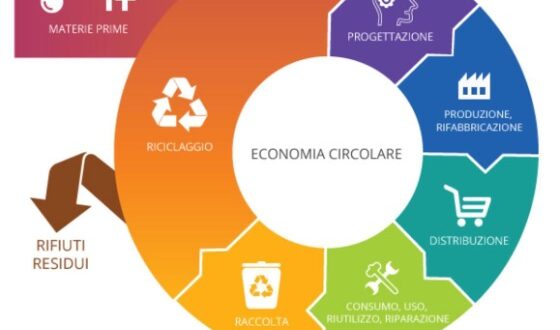THE CIRCULAR ECONOMY IN THE CONTEXT OF FOOD SYSTEMS
The concept of the circular economy (CE) represents a development model that aims to mitigate the negative impacts of human actions through the implementation of the basic principles of the ‘3Rs’: reduce, reuse and recycle [1], with the goal of constantly maintaining the highest degree of utility and value for products, components and materials [2]. The basic principle, therefore, of the circular economy is the creation of economic value for those products that until now have been regarded as industry waste.
The need to emphasise the importance of waste as raw materials stems from a culture of waste that leads us, for example, to underestimate the impact of food waste on climate emissions. Our current economic system uses the linear ‘take-produce-consume-waste’ economic model, which assumes that economic growth can be based on an abundance of resources and unlimited waste disposal. The circular economy applied to the food system implies reducing the amount of waste generated in the food system, reusing food and using waste, recycling nutrients, and changing diets towards more diverse and efficient eating patterns [3].
Data show us that the total food waste measured in 2021 in Europe was over 58 million tonnes of fresh mass (131kg of food waste per inhabitant, within the EU) [4].
After conducting the first unified monitoring of food waste across the EU, Eurostat calculated that 54% of food waste in the EU originates in households, 7% comes from the wholesale and retail sector, and 9% is attributable to restaurants and catering services. Other sectors contributing to the problem of food waste in the EU include primary production.
Food waste production thus involves all sectors of the food supply chain and is a globally impactful phenomenon that requires a joint effort. In fact, emissions associated with food loss (that which occurs along the food supply chain, from harvesting/harvesting/canning to, but not including, the sale level) and food waste (from sale to consumer) are responsible for 8-10% of anthropogenic climate gas emissions, comparable to global road transport emissions [5].
Together with high levels of food waste, the ever-increasing demand for energy and materials to meet the population’s demand for food is forcing many countries to consider the circular economy as a thrifty solution to the problem of food waste. The EU has already started to implement Sustainable Development Goal (SDG) 12.3, which aims to halve food per capita by reducing food waste along the food value chain, from producers to retailers and consumers [6].
Given the climate crisis of our century, the creation of a business model aimed at making money from a ‘waste’ product draws attention to the identification of new possibilities from a new perspective on food systems. Changing our food system from a linear to a circular model would allow us to address environmental challenges with an innovative approach aimed at protecting the environment and human health. On the other hand, the identification of new resources within the supply chain raises new questions related to environmental trade-offs. The reuse of a waste product in an existing supply chain also requires an environmental impact assessment through, for example, the identification of critical points in the process.
In the impact assessment of a product/process, the use of tools such as emission calculators can support decision-making within the food production/reuse chain.
The challenge is, therefore, not only to identify waste components as possible resources, but also to implement a transformation process that complies with a sustainable food system.
Article by Bruna Anzà, Italian Climate Network Volunteer
References
[1] Li, Huiquan, Weijun Bao, Caihong Xiu, Yi Zhang, and Hongbin Xu. 2010. “Energy Conservation and Circular Economy in China’s Process Industries.” Energy 35 (11): 4273–4281. doi:10.1016/j.energy.2009.04.021.
[2] Ellen MacArthur Foundation. 2015b. “Growth Within: A Circular Economy Vision for a Competitive Europe.” Ellen MacArthur Foundation, 100.
[3] Jurgilevich A, Birge T, Kentala-Lehtonen J, Korhonen-Kurki K, Pietikäinen J, Saikku L, Schösler H. Transition towards Circular Economy in the Food System. Sustainability. 2016; 8(1):69. https://doi.org/10.3390/su8010069
[5] Guo X, Broeze J, Groot JJ, Axmann H, Vollebregt M. A Worldwide Hotspot Analysis on Food Loss and Waste, Associated Greenhouse Gas Emissions, and Protein Losses. Sustainability. 2020; 12(18):7488. https://doi.org/10.3390/su12187488
[6] Tamasiga P, Miri T, Onyeaka H, Hart A. Food Waste and Circular Economy: Challenges and Opportunities. Sustainability. 2022; 14(16):9896. https://doi.org/10.3390/su14169896

